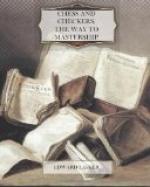If both players refrain from premature attack the game might develop as follows: (2) B-c4, B-c5; (3) Kt-f3, Kt-c6; (4) P-d3, Kt-f6; (5) Kt-c3, P-d6; (6) o-o, o-o; (7) B-g5. This move is the first one with which White trespasses the “frontier” which may be said to run in the openings of all games between the fourth and fifth ranks of the board. The Bishops are the only pieces for whom there is a field of action in the opponent’s camp early in the game. They pin a hostile Knight and thereby exert a certain pressure on the opponent who naturally does not like to see any of his pieces deprived of its mobility. The fact that Black can drive White’s Bishop away with P-h6 does not lead to any loss of time for White, for the Bishop can retire to h4, still maintaining the pin, while Black has not furthered his development by his Pawn move; in fact, he has somewhat compromised his position and as explained by the discussion of the position of Diagram 37 the advance of the Pawn g7 to g5 cannot follow without the risk that White will uphold the pin even at the cost of a piece and obtain an overwhelming attack.
That the move P-h6 creates a weakness even if it is not followed up by P-g5 will be demonstrated later on in the discussion of the middle game. The correct answer to White’s seventh move is easily found with the help of the principle of development. If White did not threaten anything Black would certainly think of nothing else than the development of his Queen’s Bishop, the only minor piece which has not yet moved. Therefore, the first thing Black should consider in countering the threat involved in White’s last move is a protection with a move of the Queen’s Bishop. White’s threat is (8) Kt-d5, attacking the Knight f6 for the second time. Although the Knight is twice protected, Black will naturally endeavor to prevent an accumulation of hostile pieces on the point f6, and he can do that indeed very easily by playing (7) ...., B-e6 with a view toward capturing the Knight if he should move to d5.
The exchange (8) Kt-d5, Bxd5; (9) Bxd5 is manifestly not desirable for White, as it does not improve in any way the mobility of his men. On the contrary, White loses a move, as the result of the maneuver is only a change of location of the King’s Bishop who was already developed while the principle of speedy development demands that no piece should be moved twice in the opening until all pieces are developed.
Unless Black’s move involves a threat which needs immediate attention White should consider only such moves as will secure a possibility of development for his Rooks, that is maneuvers which are liable to produce an open file somewhere on the board.




